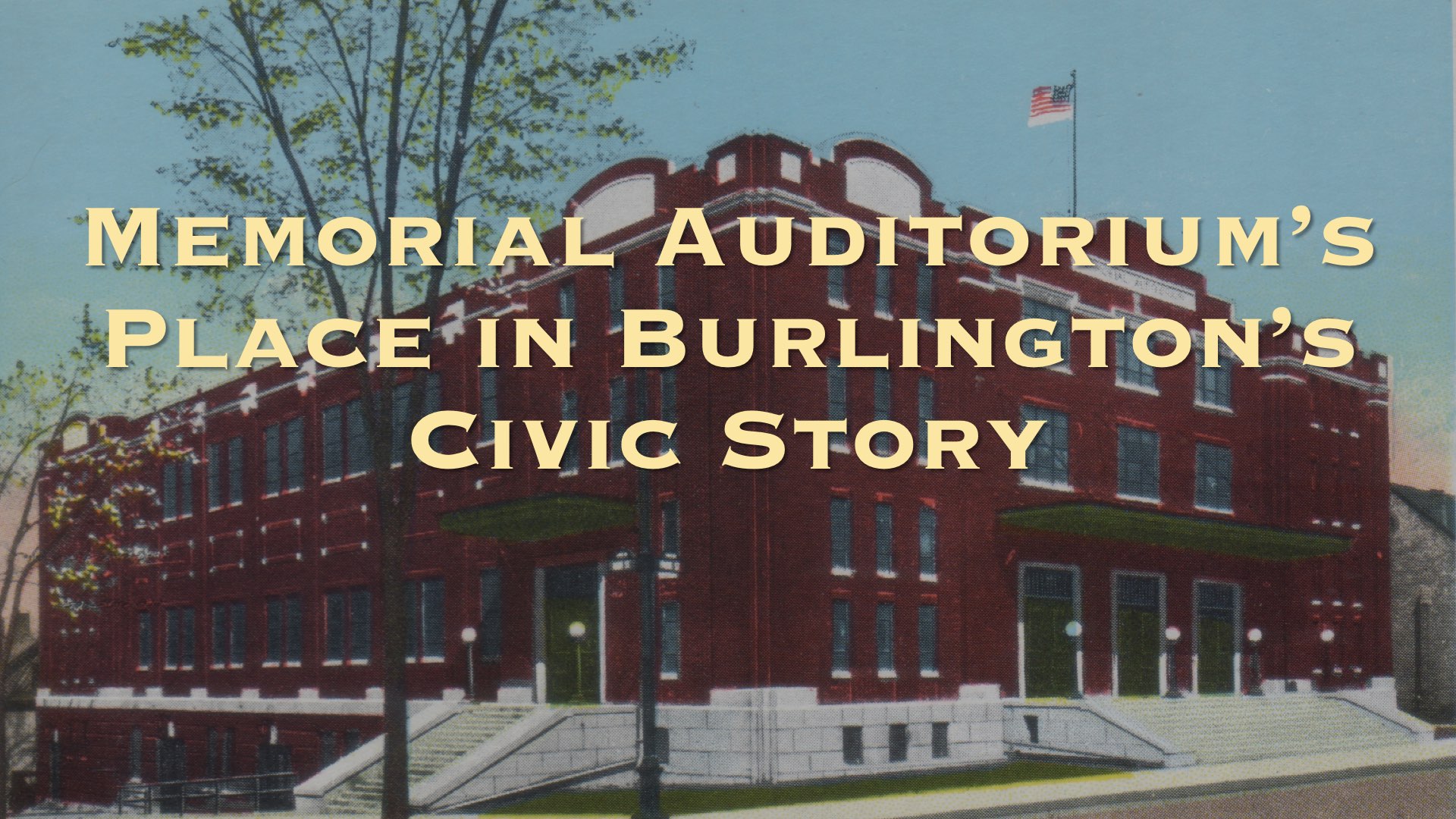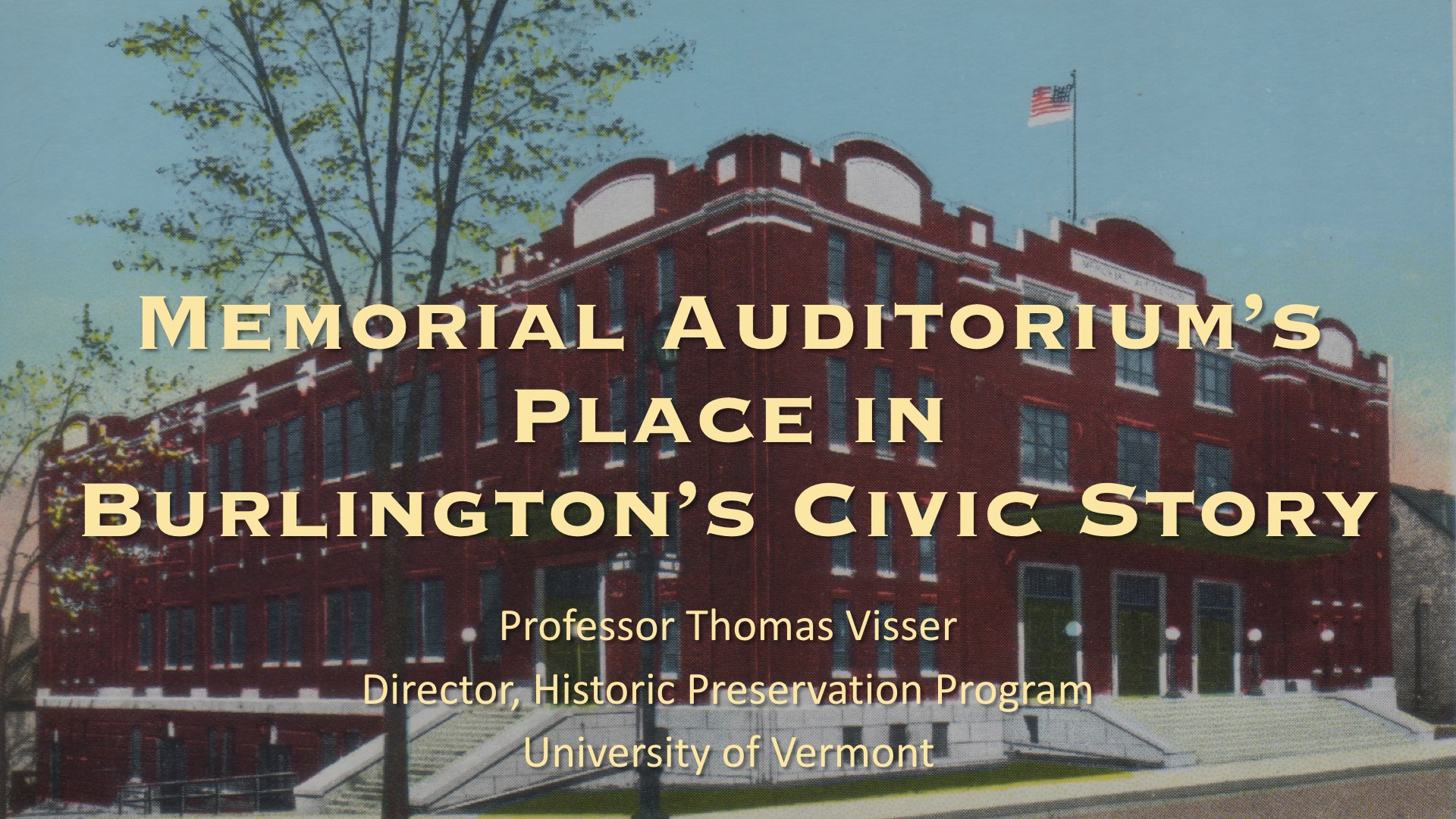
Memorial Auditorium's Place in Burlington's Civic Story
The following was presented by Prof. Thomas Visser of the University of Vermont Historic Preservation Program at the City-wide Assembly on the Future of Memorial Auditorium held by the Burlington Neighborhood Planning Assembly at Contois Auditorium in Burlington City Hall on September 26th, 2017.
Thank you very much for the invitation to speak about Memorial Auditorium’s place in Burlington’s civic story. And thank you to everyone involved in organizing this important city-wide event. This conversation comes at a very critical time. And as a long-time Burlington resident who cares deeply about the future of our city by the lake, I trust that many of you also share deep connections and hopes for the future of this very special place in our city—a space that for generations has served as a remarkable common ground of engagement for everyone in the Burlington community.
First, I would like to let you know about some research on the early history of Burlington's Memorial Auditorium that is now available online. Second, I would like to share some highlights of historical information about Memorial Auditorium's place in Burlington's civic story. And third, I have prepared a short video.
Each fall semester in an introductory historic preservation course that I teach at the University of Vermont, our students learn about historical research methods by taking on a collaborative project. For physical convenience and due to the quality of archival resources available at the UVM Library’s Special Collections, most of these projects have focused on the history of Burlington. Since the year 2000, we have published the findings of many of these projects on-line as a community service.
Last fall, our research theme was 1920s Burlington Landmarks. For this, our graduate students researched the stories behind the construction of five major Burlington landmark buildings during the optimistic years of the Roaring Twenties, including a piece on Burlington’s Memorial Auditorium, researched by Emma Haggerty.

Emma meticulously tracked the intricate story of the inspiration and challenges that led to the construction of Burlington’s Memorial Auditorium, a civic treasure that is listed on both the National Register of Historic Places and the Vermont Register of Historic Places. The fascinating story that Emma presents, chronicles how a complex web of community aspirations, progressive ideals, financial constraints, resourceful politics and collective gratitude all culminated in the creation of a truly remarkable community space. But rather than attempting to re-tell the entire story that Emma Haggerty has researched, I invite you to read it online. Just search for "1920s Burlington Landmarks."

In the context of this evening’s discussions, I would like to build on Emma Haggerty's research by sharing some samples of how Memorial Auditorium’s place in Burlington’s civic story has played out over the decades.
Here, then, is a quick timeline that highlights some samples from Memorial Auditorium’s history:
To start, it was in 1925 that the Burlington Free Press editor-in-chief called for the construction of a large new separate “memorial auditorium” with “tablets on the walls of the main lobby,” rather than incorporating a smaller memorial hall into the new city hall that was then being planned for Church Street.

In January 1926, the Burlington mayor’s office presented plans for a new city hall on Church Street with a 1000 seat auditorium within, but many citizens complained that the city should should build a completely separate building at another location for a larger civic auditorium instead.
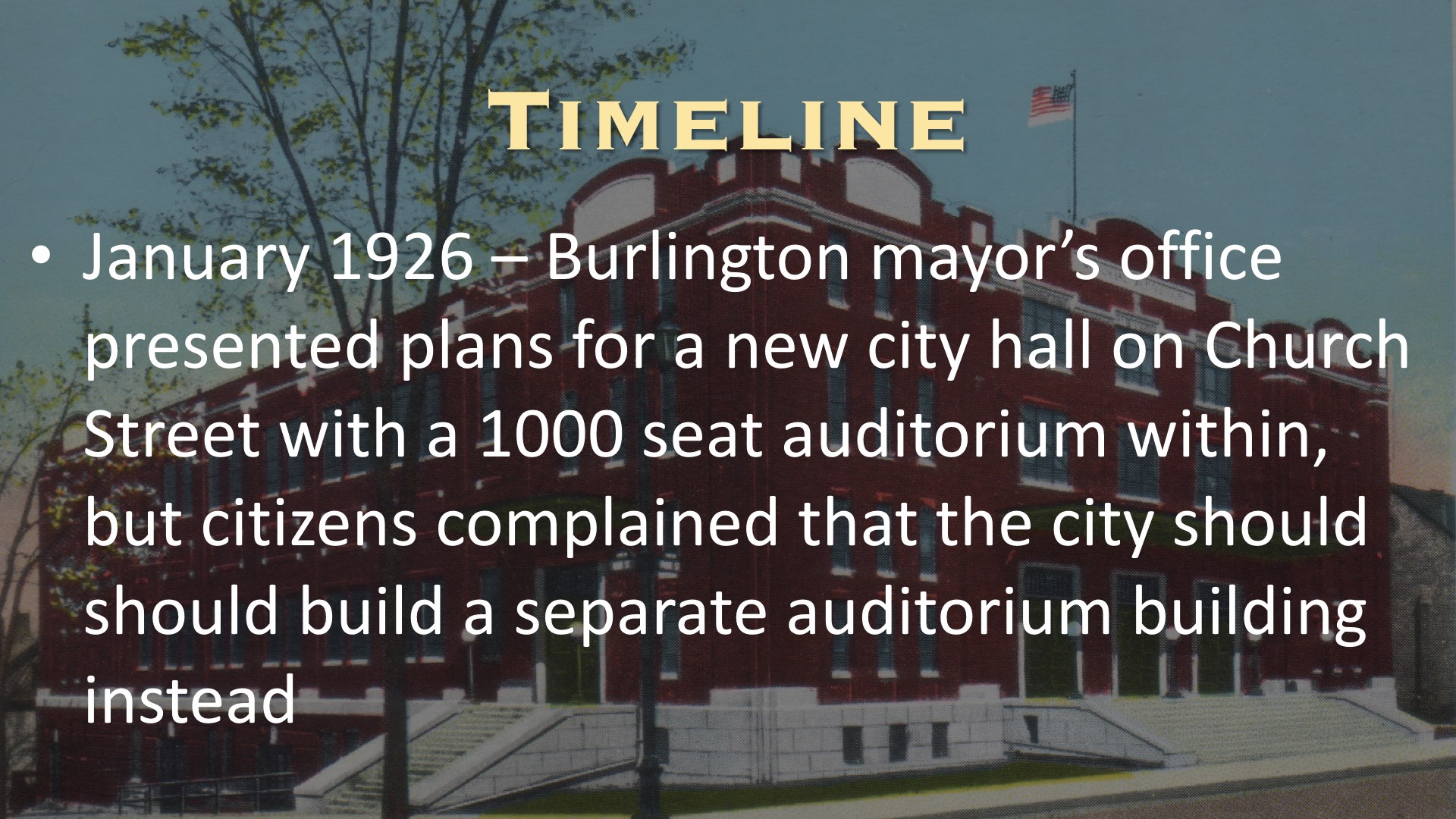
In response to these concerns of the citizens, a new plan for a new city hall on Church Street was revealed by the city without an auditorium in February 1926, designed by the noted architectural firm of McKim, Mead & White.
It was also announced that a plan for a separate new “memorial auditorium” with a capacity of 4,000 people to be located at the corner of Main Street and South Union Street would be brought to the city’s voters at the “city meeting” in March.

At the “city meeting” in March 1926, Burlington voters approved the construction of a new memorial auditorium, designed by Burlington architect, Frank L. Austin, who also designed the Burlington Central Fire Station and the Burlington Junior High School, and within a month brush was already being cleared and ground was broken at the corner of Main Street and South Union Street for the new building.
By December 1926, however, work was stalled as it became clear that a voter approval would be needed to authorize the expenditure of more funds for construction. Voters subsequently approved these additional funds in a special city meeting late in the month.
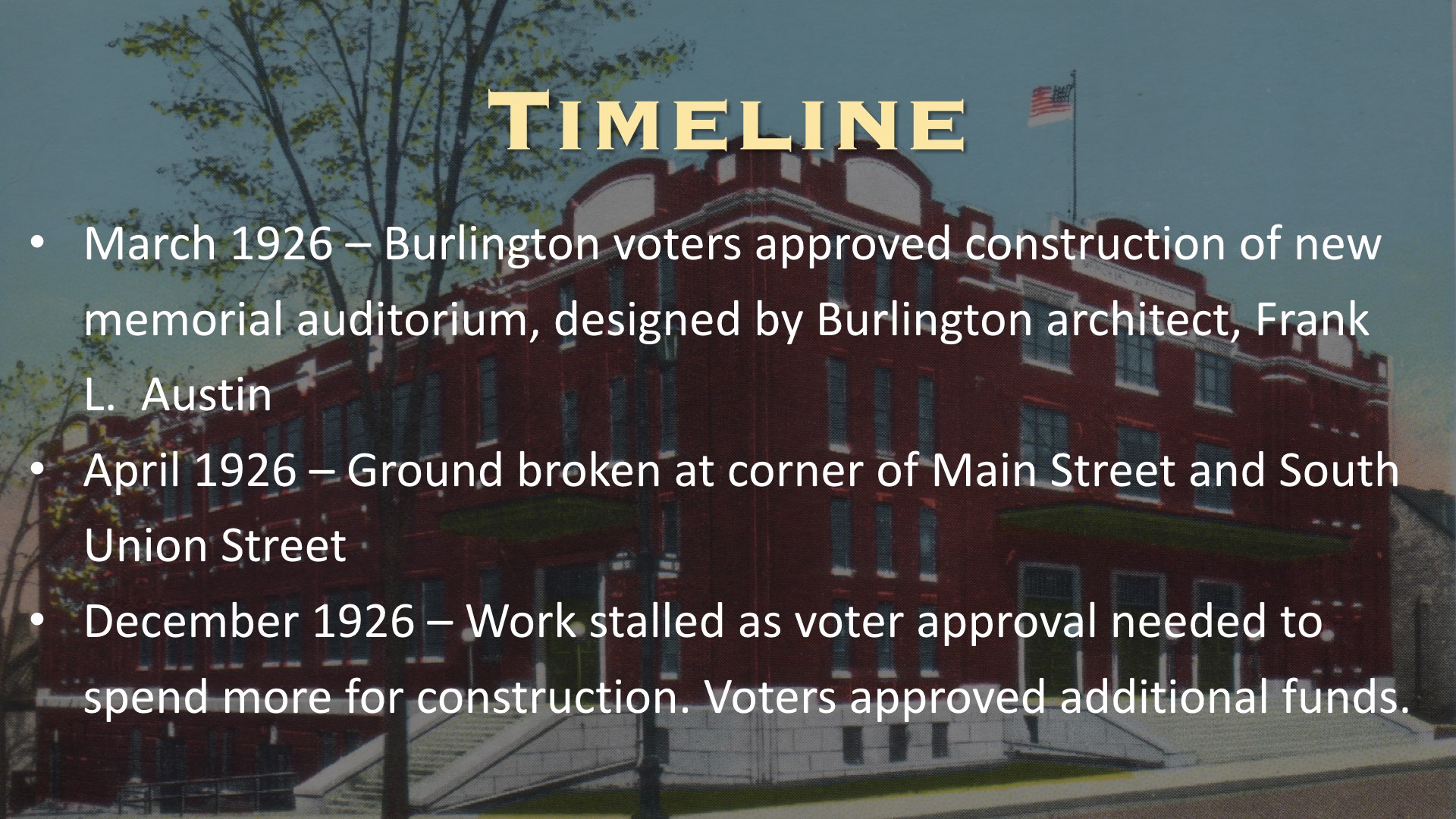

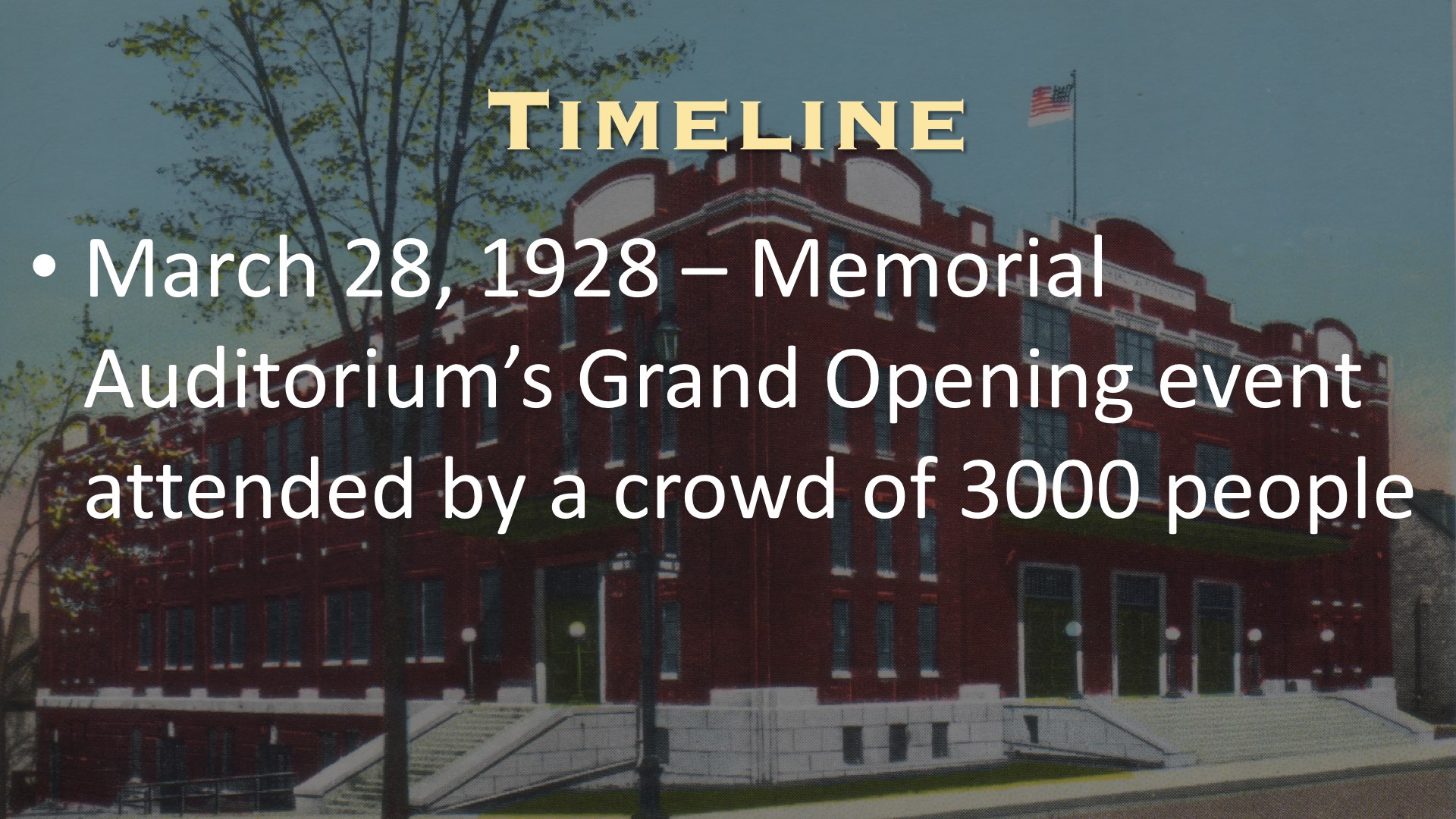
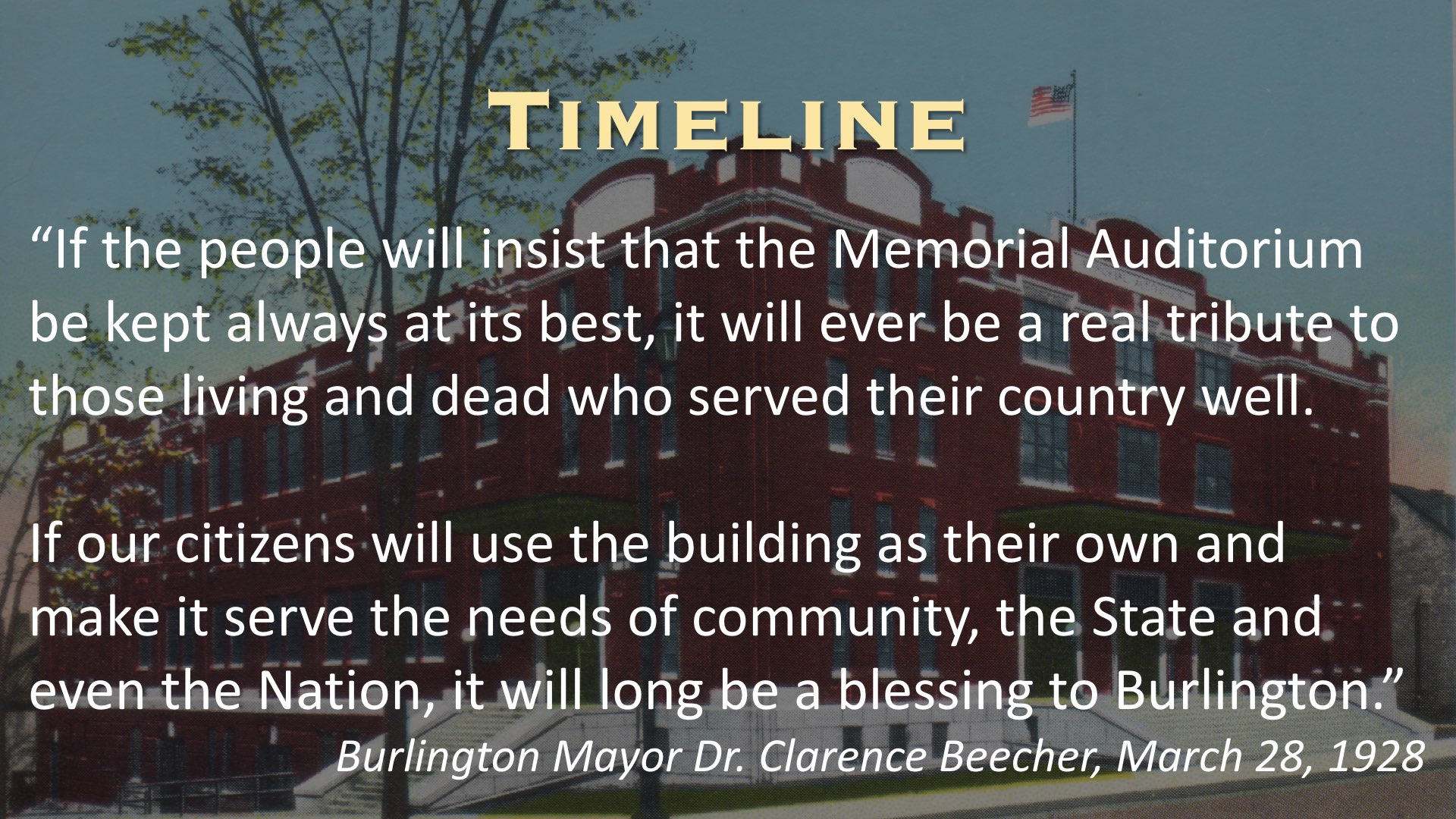
• April 9, 1928 – “Everybody invited” to the Elks Charity Ball at Memorial Auditorium
• April 15, 1928 – First concert in Memorial Auditorium by the Burlington Symphony Orchestra – attended by 1,700
• April 19, 1928 – An estimated record crowd of 2,000 attended the annual Burlington Firemen’s Ball
• April 20, 1928 – A four-bout Friday evening boxing match was held in the Memorial Auditorium basement
• April 24, 1928 – Dancing with Mack Bergman’s “real hot band”

• On May 2, 1928 – Burlington’s American Legion held its 10th anniversary ball in Memorial Auditorium
• On May 3, 1928 – Tony Sarg’s “world famous marionettes” appeared for children audiences
• On May 5, 1928 – Vermont Republican party held a caucus attended by over a thousand people in Memorial Auditorium
• And on May 7, 1928 – The 7th Field Artillery Military Band performed at a “patriotic mass meeting” of the Vermont Commandery of the Military of the Loyal Legion with a choir of over 100 voices.

• On May 11, 1928 – Peter W. Collins of Boston presented a lecture on “Subversive Movements in America” under the auspices of the Knights of Columbus to an audience of 800
• On May 12, 1928 – Seven school orchestras from around the state competed for prizes at Memorial Auditorium on the same day that construction of the new Burlington City Hall on Church Street was completed
• The next night on May 13, 1928 – Burlington Symphony Orchestra presented a concert
• Two days later, on May 15, 1928 – the Vermont Democratic party held their state convention in Memorial Auditorium
• Then on May 17, 1928 – there was a concert by the Burlington High School Orchestra and Band
• And the next day, on May 18, 1928 – the Vermont Republican party held their state convention here.
• And then that night, the UVM Junior Prom was held in the Memorial Auditorium building.

• On February 6-9, 1929, the Burlington Automobile Show, the “largest show north of Boston” was held here.
• On March 17, 1931, it was the Vermont Sportsmen Show. According an ad in the Free Press, “Dog lovers will flock to the basement floor of the auditorium where it is said 110 dogs of all sporting breeds will be on display.”
• In November 12, 1936, the Vermont Farm Bureau held their annual banquet here “with dancing to follow”
• On October 30, 1937, a “Community Halloween Celebration was held at Memorial Auditorium, preceded by a costumed parade”
• On March 4, 1938, it was the Northern District Basketball Tournament
• And on July 27, 1939, Rudy Vallee, one of America’s first modern pop music stars, who was born in Island Pond, Vermont, performed with his entire orchestra of 30 pieces at Memorial Auditorium “for his birthday…”
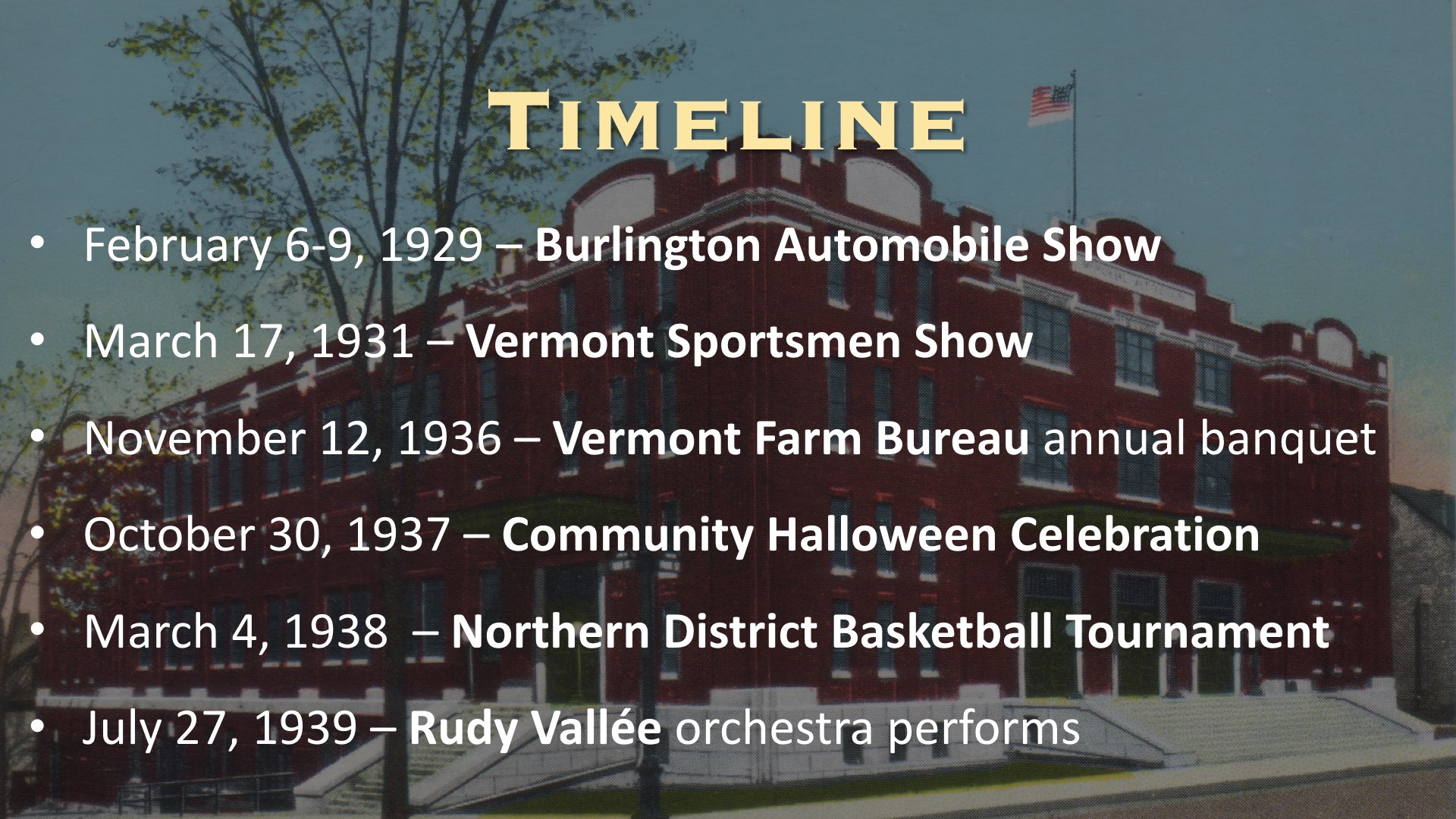
• June 17, 1940 – Tom Dewey, GOP presidential candidate speaks to “several thousand at Memorial Auditorium”
• August 1, 1940 – Speech by Dorothy Thompson advocating a “United States of the English-speaking people” attracts 2,000
• October 10-11, 1940 – 2,500 at Vermont Education Association convention
• December 15, 1940 – Mac’s Circus benefit performance for children to support “Bundles for Britain” war aid.
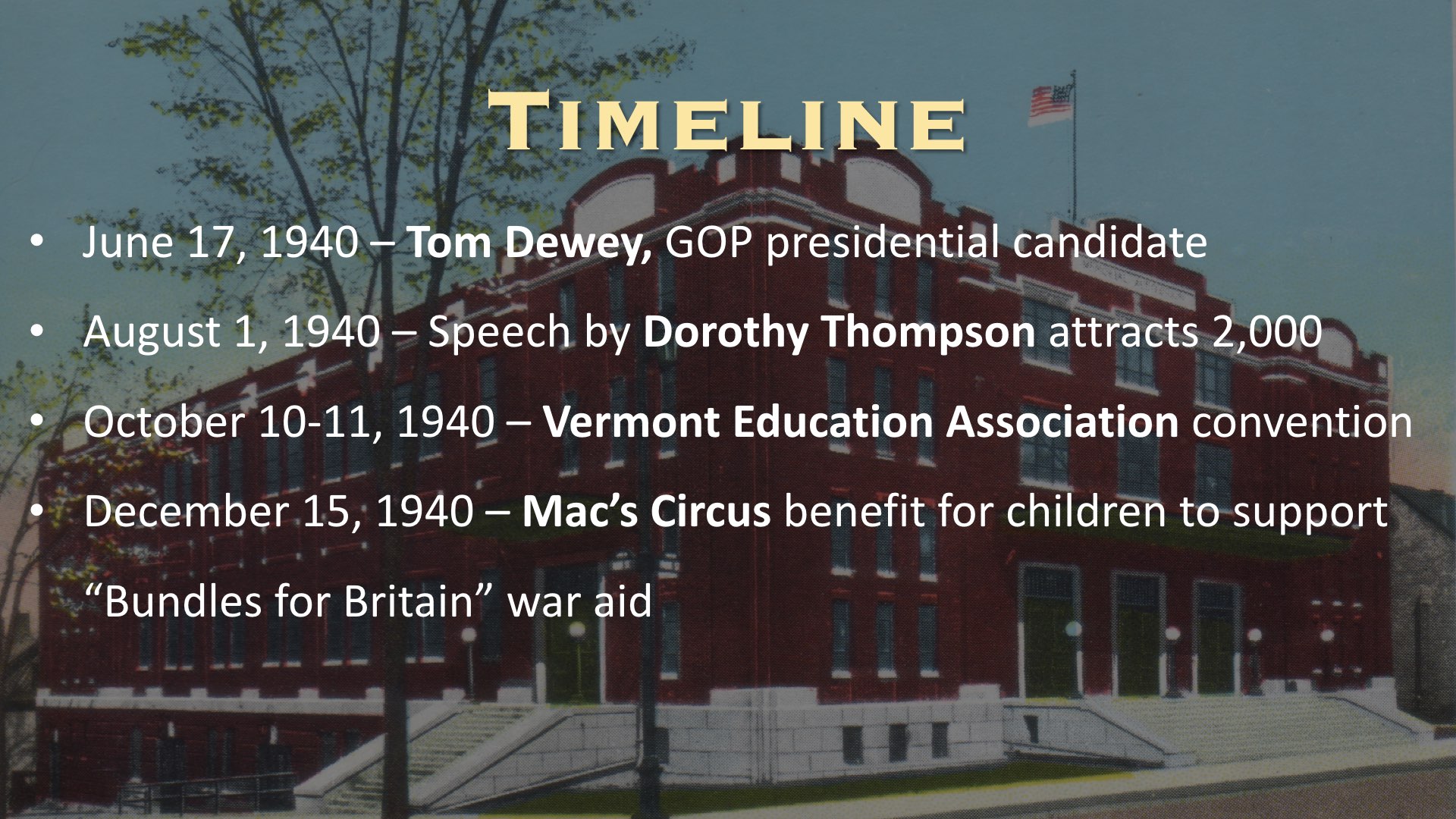
• July 1, 1955 – U.S. Immigration & Naturalization Service offices in basement of Memorial Auditorium – “Our location here is not an experiment, but the temporary nature of the office space is still an open question… City officials have expressed a willingness to renew the lease at a $20,000 annual rental.”
• October 13, 1955 – About 1,200 teachers and school officials attend Vermont Education Association annual convention. In the keynote speech, Dr. Mortimer Adler said, “American education today is still running away from the problem of how to give all American children a liberal schooling.”
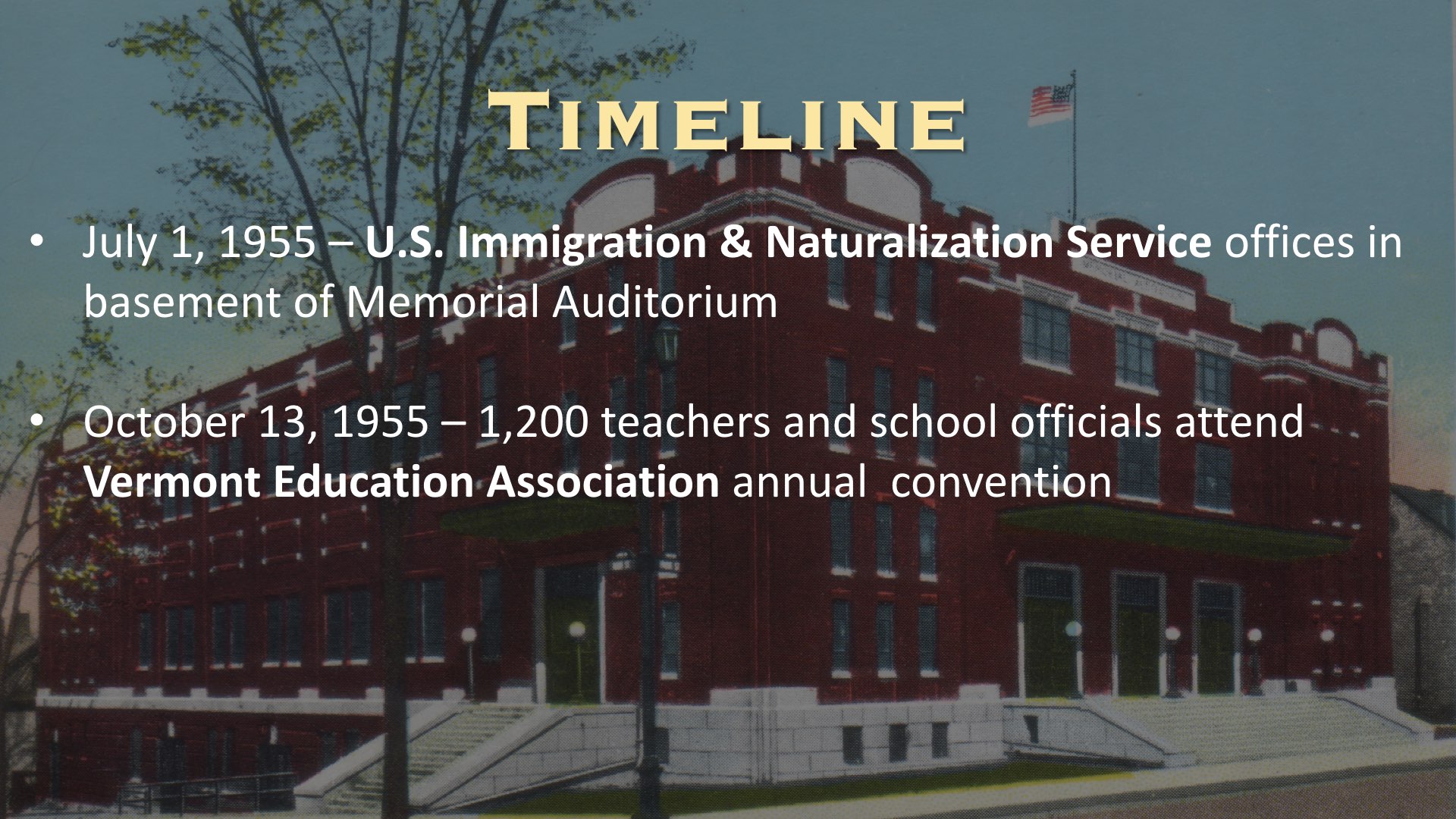
• On February 2, 1962 – It was announced that “Burlington’s Welfare Department hopes to begin distributing food to the city’s needy from a new room in the basement of Memorial Auditorium in March.”
• On March 12, 1967 – Simon & Garfunkel performed here
• On September 19, 1964 – Senator Barry Goldwater “will make a speech at Memorial Auditorium”
• And on September 11, 1968 – After some complaints about the acoustics and conditions in the auditorium, it was announced in the Burlington Free Press that: “A $5,000 concert shell has been purchased by the Lane Series of the University of Vermont for use on the Memorial Auditorium stage… Other improvements include painting of the stage walls, repair of the corridor walls, and repair of the roof in preparation for a new roof surface next year… The auditorium was found to be up to its usual high standard of cleanliness.”
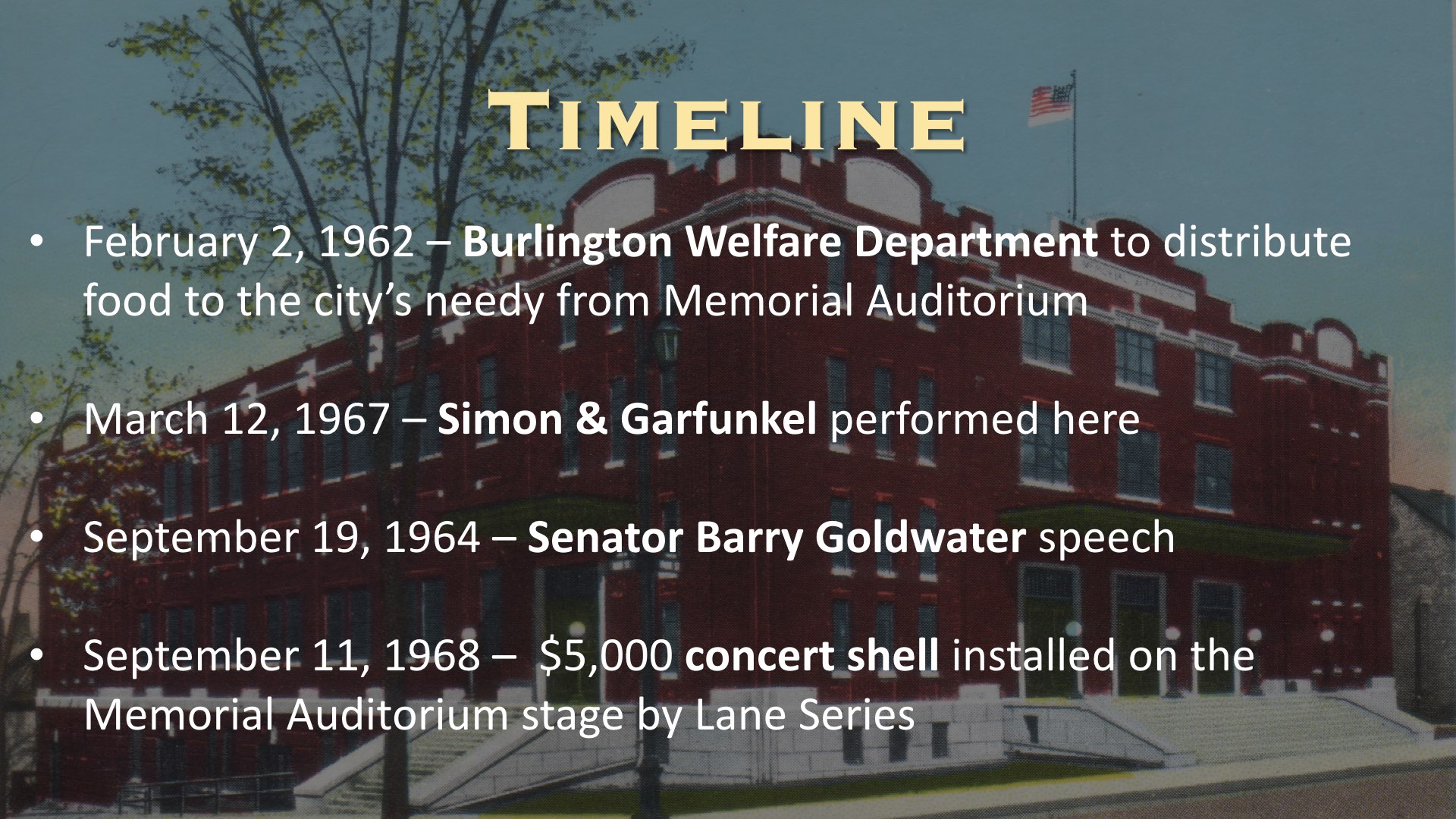
• March 29, 1986 – “242 Main opened last weekend with an art exhibit, two rock bands and about 200 teen-agers…”
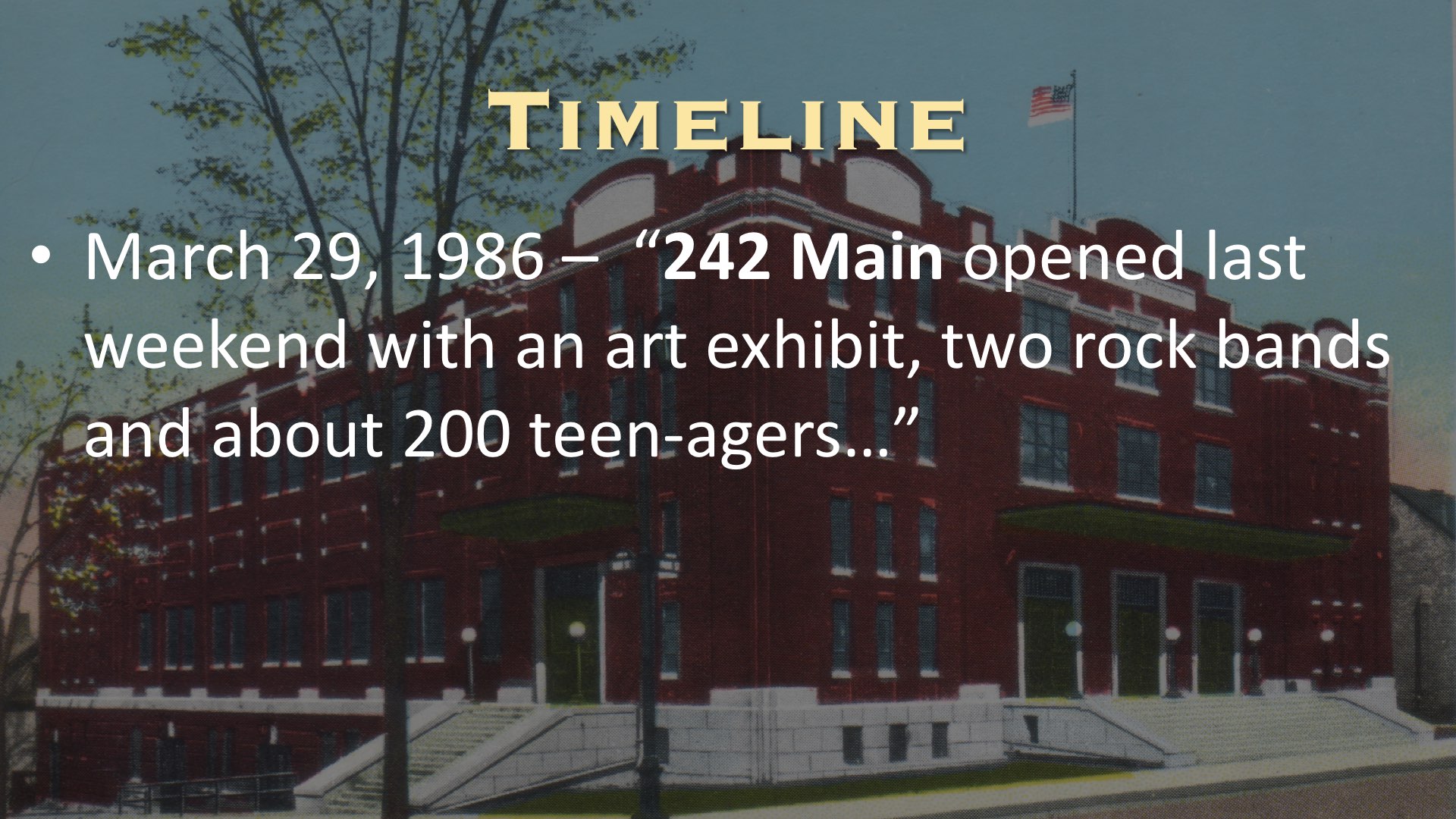
Here is a sample of some events from the ’80s:
• April 4, 1986 – Chuck Barry, “The Father of Rock ’n Roll, In Concert”
• September 19-20, 1986 – Jim Henderson’s Muppet Babies, Live!
• March 27-29, 1986 – Lake Champlain Boat Show
• September 18, 1987 – Rock ‘n’ rollers, Twisted Sister
• January 21, 1988 – Alice Cooper with special guest Motorhead
• April 16, 1988 – Ricky Scaggs
• April 24, 1988 – Howie Mandel
• August 16, 1988 – Joan Aramatrading
• October 17, 1988 – Little Feat
• December 6, 1988 – Robert Palmer

• On October 13, 1988 – Memorial Auditorium was listed on the National Register of Historic Places as a contributing building within the Main Street – College Street Historic District. This was one of an array of historic districts in downtown Burlington listed on the National Register in response to the gentrification pains that urban renewal had brought to the community. Indeed Burlingtonians had seen first-hand how its thriving mixed residential and commercial neighborhood between the downtown business core and the Lake had been destroyed after being called a slum by planners in order to get federal funds. They had heard the heart-wrenching stories of the many families that had been displaced. And despite all the big promises, after decades all that stood on the huge urban renewal site were a few big boxes for banks, offices, a hotel, and some government-funded buildings. Recognizing that historic preservation could be an effective tool to help protect from the interests of gentrification, Burlington became nationally known for its progressive efforts to serve the needs of all its citizens.

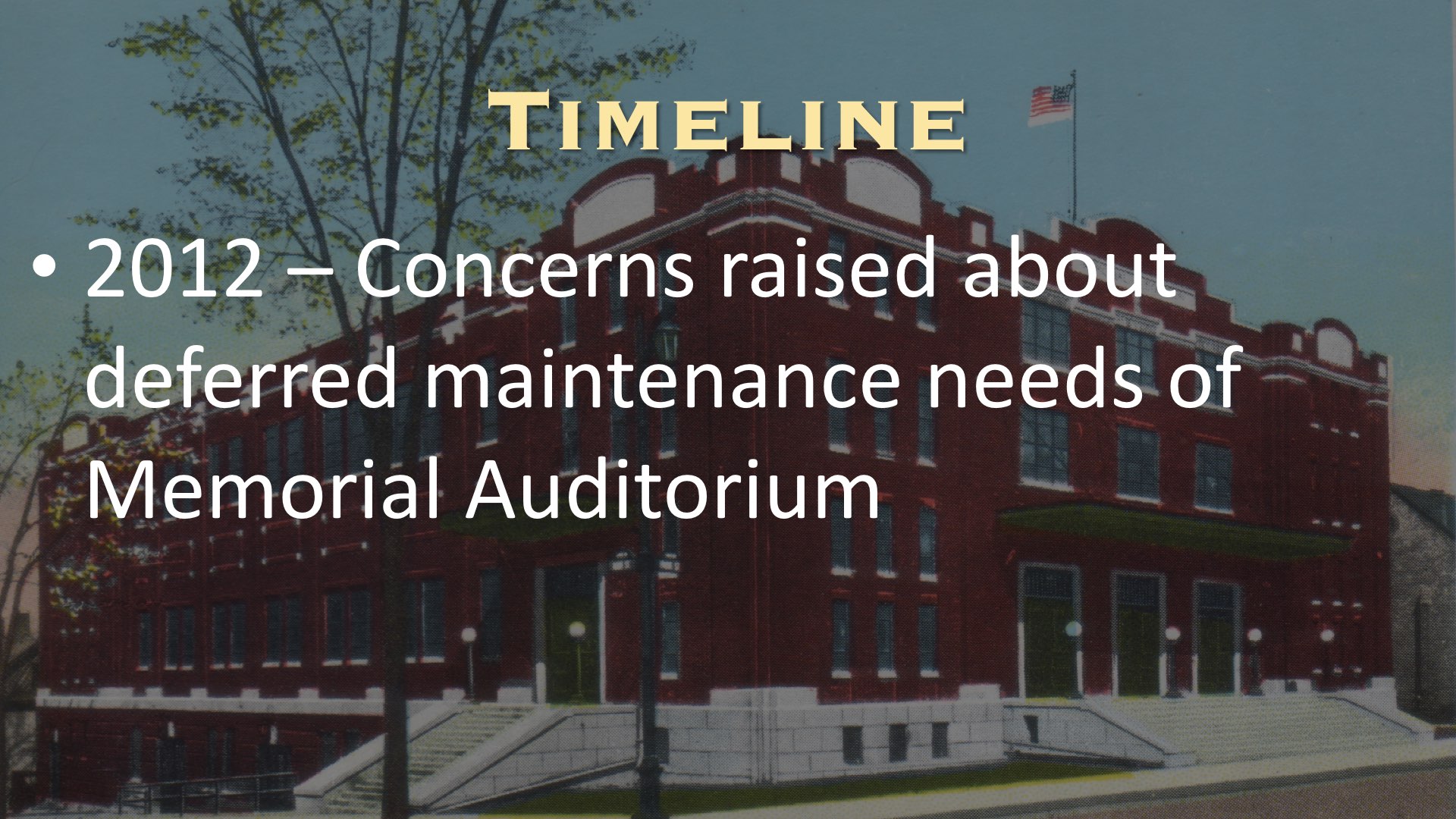
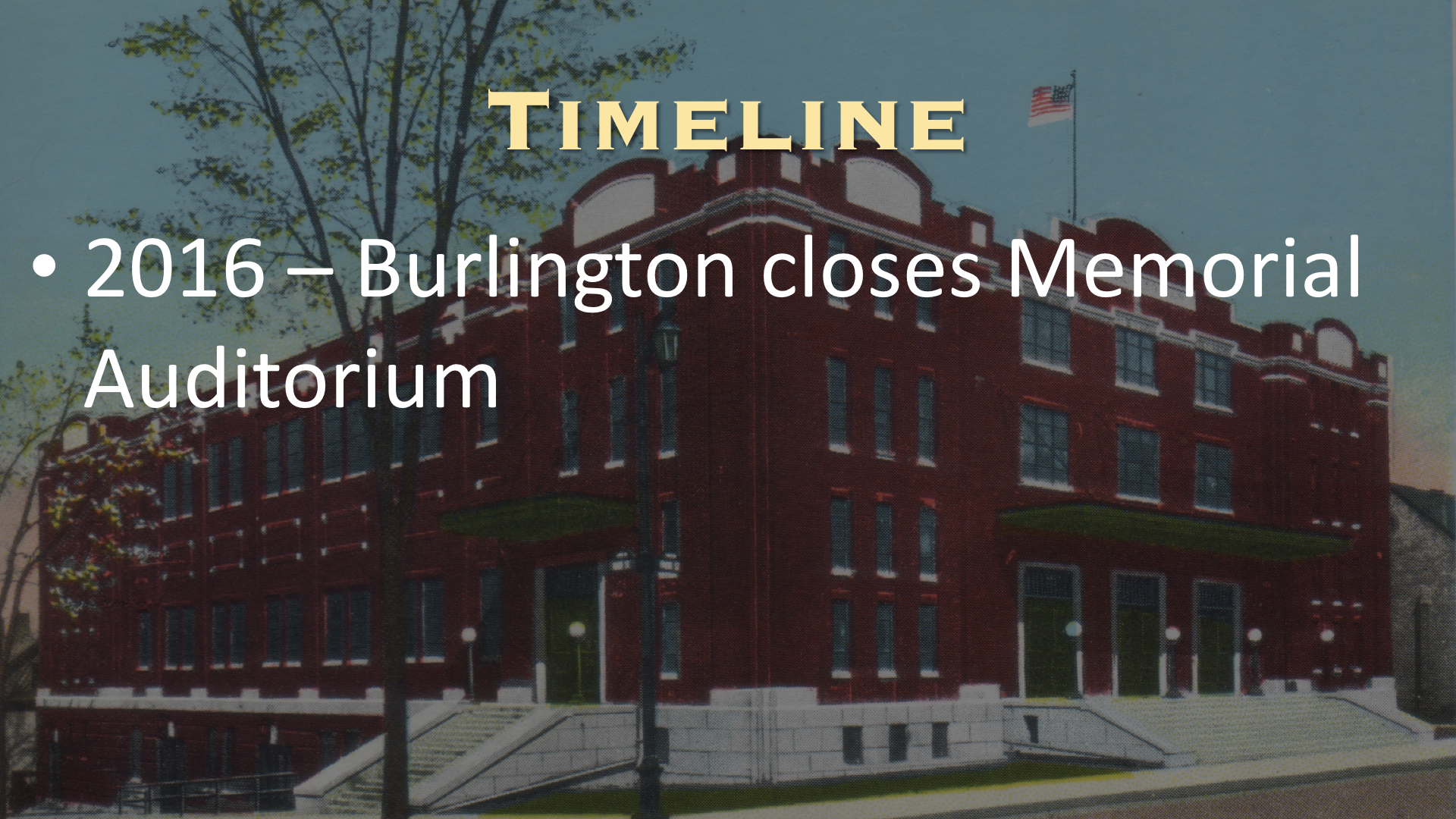
Concerned about the fate of Memorial Auditorium, I started a project to document Memorial Auditorium and its place in Burlington’s history.
And from that, here is a link to a short video with images of many of the above events that I hope captures some of the feelings associated with the history of this community landmark.
In closing, let me just suggest that rather than letting Memorial Auditorium continue to wither away, let us now, as a community, support efforts to develop a plan that preserves Burlington's Memorial Auditorium so that it may continue to serve as the place where everyone is welcome to participate in Burlington’s civic story.